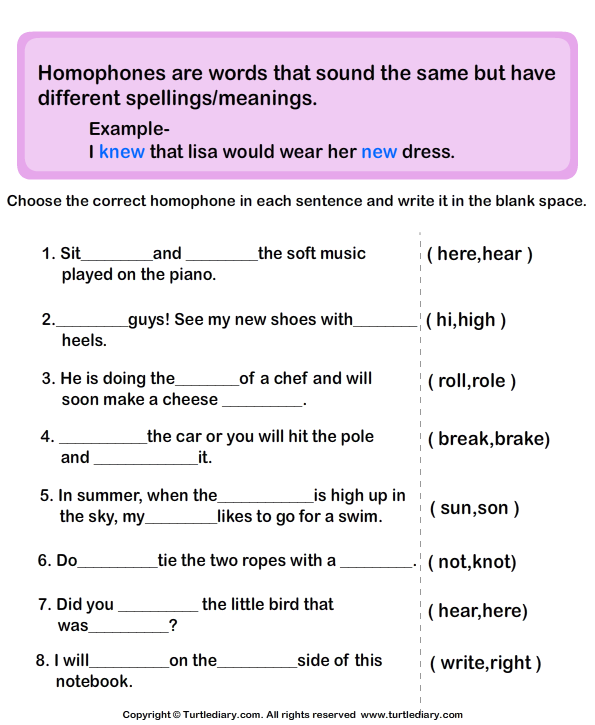Have you ever been caught in a writing dilemma, unsure which word to use when faced with those tricky homophones? The English language can be a real puzzle, especially when words sound alike but have vastly different meanings. I remember the first time I realized that “there,” “their,” and “they’re” were not interchangeable. I was writing a school paper about the history of the Roman Empire and used the wrong word, resulting in a very confused sentence. You can imagine the look on my teacher’s face! It was a good lesson in the importance of understanding homophones.

Image: www.turtlediary.com
Homophones are words that sound the same but have different spellings and meanings. They are often a source of confusion for writers, and even native speakers can stumble from time to time. But fear not! This guide will equip you with the knowledge you need to confidently choose the right homophone for any situation, ensuring your writing is clear, precise, and free from embarrassing errors.
Understanding the Nuances of Homophones
The Importance of Context
The key to correctly using homophones lies in understanding their contexts. Each homophone carries a specific meaning, and selecting the right one depends on the intended message you want to convey. Take, for example, the words “to,” “too,” and “two.” While they sound identical, their meanings are entirely different: “to” indicates direction, “too” means excessively, and “two” refers to the number. Knowing the context, such as the surrounding words and the overall meaning of the sentence, allows you to pick the appropriate homophone.
Commonly Confused Homophones
Let’s delve into some of the most frequently encountered homophone pairs and explore their nuances in detail:
- “Your” and “You’re”: “Your” is a possessive adjective, indicating possession. “You’re” is a contraction of “you are.”
- Example: “Your homework is due tomorrow.”
- Example: “You’re doing a great job.”
- “There,” “Their,” and “They’re”: “There” indicates a place or location. “Their” is a possessive adjective, indicating ownership for a group. “They’re” is a contraction of “they are.”
- Example: “The book is over there on the table.”
- Example: “This is their house.”
- Example: “They’re coming to the party later.”
- “Its” and “It’s”: “Its” is a possessive adjective, indicating ownership for a thing. “It’s” is a contraction of “it is.”
- Example: “The dog wagged its tail.”
- Example: “It’s a beautiful day outside.”
- “Then” and “Than”: “Then” signifies time or sequence. “Than” is used for comparisons.
- Example: “First, we went to the store, then we went home.”
- Example: “I like pizza more than pasta.”
- “Affect” and “Effect”: “Affect” typically acts as a verb, meaning to influence or change something. “Effect” can be a noun, referring to a result or consequence, or a verb, meaning to bring about or cause something.
- Example: “Stress can affect your concentration.”
- Example: “The new policy had a significant effect on the company’s performance.”

Image: ubicaciondepersonas.cdmx.gob.mx
Expert Tips for Mastering Homophones
1. Focus on the Context
The first rule of thumb is to always consider the context surrounding the word in question. Pay attention to the surrounding sentences, the overall tone of the writing, and the message you want to convey. This will help you determine which word fits best.
2. Use a Dictionary or Thesaurus
If you’re still unsure about the correct homophone, don’t hesitate to consult a dictionary or thesaurus. These tools are invaluable for providing accurate definitions and usage examples.
3. Proofread Carefully
Once you have completed your writing, carefully proofread your work to catch any potential homophone errors. Reading aloud can be particularly helpful in identifying mistakes that you might miss when reading silently.
FAQ: Homophones
Q: Are there any rules or tricks to help me remember which homophone to use?
A: While there aren’t strict rules, understanding the meanings of common homophones and practicing their usage can help you remember them over time. Remember that if a word is possessive, it usually ends with “-s.” If a word indicates time or something is happening, then it usually includes “then” or “they’re” or a contraction.
Q: Should I avoid using homophones altogether?
A: Not at all! Homophones are a natural part of the English language, and using them correctly can add depth and nuance to your writing. While it’s essential to be mindful of their correct usage, there’s no need to shy away from them.
Choose The Correct Homophones To Complete The Sentence
Conclusion
Mastering the use of homophones is an essential skill for any writer. By understanding their meanings and practicing their usage, you can ensure your writing is clear, precise, and free from embarrassing errors. Remember to focus on context, consult dictionaries and thesauruses when needed, and proofread carefully. The beauty of the English language lies in its flexibility and nuances, and choosing the right homophone can make all the difference in your writing.
Do you find homophones to be a challenge? Share your experiences in the comments below!






